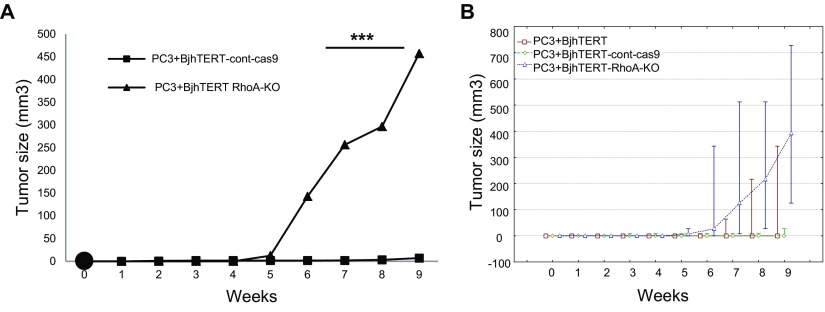Fig. S3.
CRISPR-Cas9–mediated RhoA gene knock-out in human immortalized BjhTERT fibroblasts promotes tumor-stimulatory capacity of fibroblasts in SCID-beige mice. (A) Dynamics of tumor growth in SCID-beige mice injected with mixtures of PC3 mRFP prostate cancer cells with BjhTERT–cont-cas9 or BjhTERT RhoA-KO fibroblasts. PC3 mRFP cells alone and with BjhTERT fibroblasts did not form tumors (not shown for clarity). ***P < 10−10. (B) Dynamics of tumor growth in SCID-beige mice injected with mixtures of PC3 mRFP cells with BjhTERT, or BjhTERT–cont-cas9, or BjhTERT RhoA-KO fibroblasts. Middle points: medians; whiskers: minimum-maximum ranges at each time point for each group. According to the Kruskal–Wallis nonparametric test, the 10 time points of BjhTERT RhoA-KO fibroblasts taken together are significantly different from those of the control fibroblasts (P = 0.000006). The two control fibroblasts were not different from each other (P = 0.70, P = 0.49). Apart from the curve dynamics, significance was also estimated for tumor onset frequencies between the BjhTERT RhoA-KO fibroblasts (n = 5) and the pooled control fibroblasts (n = 10) at fixed time points [e.g., week 7: there were tumors in 3 of 10 controls versus 5 of 5 KOs (P = 0.026; Fisher's exact test); week 9: 4 of 10 versus 5 of 5, respectively (P = 0.044; Fisher's exact test)]. Therefore, the mice without the RhoA-KO fibroblasts had significantly fewer tumors at both of these time points.

